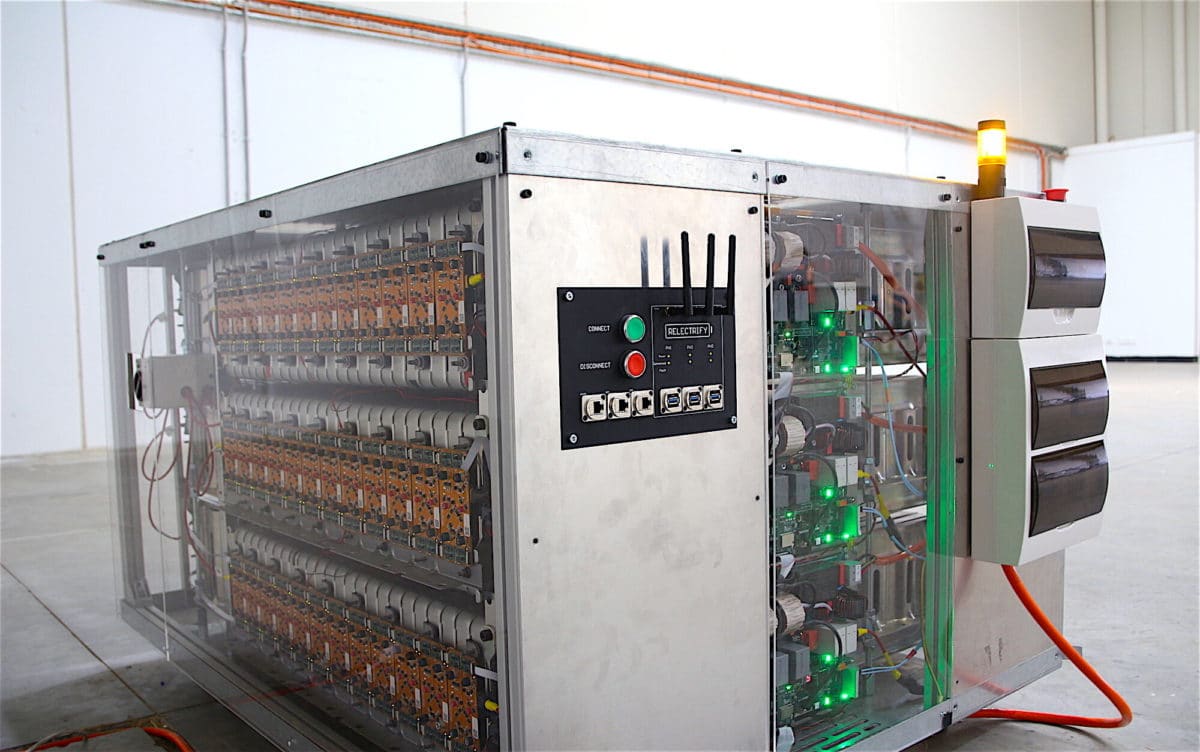After a year of functional and lifetime testing, Relectrify has released interim results of the company’s pilot system that combines repurposed batteries from Nissan Leaf vehicles with Relectrify’s BMS+Inverter technology.
The pilot, done in collaboration with utility American Electric Power (AEP) and Nissan North America, combines second-life batteries equivalent to 4.5 electric vehicles with cell-level battery management systems (BMS) to provide a high-efficiency AC output without requiring an inverter.
The resulting second-life storage system, clocking in at 60 kWh of storage capacity, creates grid-compliant AC waveforms by orchestrating a number of individual cell voltage contributions within a battery pack.
“In this pilot, we took a set of batteries that had come out of the equivalent of 4.5 electric vehicles, no testing, no sorting, put them straight into the unit, plugged our electronics in and our electronics unlocked the full capacity,” Relectrify cofounder and CEO, Valentin Muenzel, told pv magazine.
The system has undergone 500 charge and discharge cycles into and out of the grid, the majority at over 20 kW continuous power, for a total energy throughput in excess of 25 MWh. Over the course of testing, the pilot system achieved a round-cycle efficiency averaging approximately 88% AC-to-AC, including charge and discharge conversion.
Project background
The pilot was originally born out of the Free Electron Program, a utility accelerator for startups where utilities work with energy startups to consider how their technologies can help the utilities’ business model. AEP took an early interest in Relectify and their technology.
Around the same time, Relectrify began working with Nissan and Nissan’s 4R Energy Japan subsidiary, with those two entities helping Relectrify to develop the technologies that make the system work.
The pilot began to come together a year later before finally being launched in December of 2019, marking the first time the technology had been taken out of a lab setting, according to Muenzel.
“This was the first time we took this technology out of the lab and into the real world,” Muenzel told pv magazine. “We expected that it would be installed and perform somewhat, but where we were unsure was how the lifetime of these batteries was going to look, what is the efficiency of these packs and, overall, how does it perform in a real-life setting, managed by someone other than us?”
Exceeding expectations
“The efficiency is higher than we thought and the lifetime is tracking better than we thought, particularly considering that the temperature these battery packs are in and the number of cycles they’re undergoing is a lot higher than you would see in most applications,” said Muenzel.
The entire pilot, thus far, has been conducted with the battery operating outside of optimal conditions, in order to prove the resiliency and safety of the system. This was done on purpose, with all involved parties wanting to be confident in these factors, considering that those are chief concerns with second-life batteries.
“We would much rather stress test these batteries, and know that they stand up in that, than put them under optimal conditions.”
The system is trending toward an expected lifespan of 3,000 cycles, surpassing the 2,000 that the Relectrify team predicted at the onset of the pilot. Muenzel also pointed out that the 3,000 cycle estimation is still a conservative one and that the actual figure could be higher still.
Market application
While Relectrify technology is applicable to both new and second-life batteries, Muenzel expects that the two will end up having very different usage cases. He pointed out that a similar second life system would for example be particularly competitive in a backup power role, where the battery is being cycled once a week or less. The system would not be as well suited to something like frequency response, as it would quickly wear down due to the multiple daily cyclings.
However, in low-cycle backup scenarios, the pilot’s biggest advantage comes from the capital expenditure savings that come from using second-life batteries. The system also reduces the cost of battery management and inverter electronics up to 30%, according to Relectrify, with modular packs integrating the three-phase Relectrify BMS+Inverter, second-life battery modules and racking, priced from $150/kWh.
This content is protected by copyright and may not be reused. If you want to cooperate with us and would like to reuse some of our content, please contact: editors@pv-magazine.com.









By submitting this form you agree to pv magazine using your data for the purposes of publishing your comment.
Your personal data will only be disclosed or otherwise transmitted to third parties for the purposes of spam filtering or if this is necessary for technical maintenance of the website. Any other transfer to third parties will not take place unless this is justified on the basis of applicable data protection regulations or if pv magazine is legally obliged to do so.
You may revoke this consent at any time with effect for the future, in which case your personal data will be deleted immediately. Otherwise, your data will be deleted if pv magazine has processed your request or the purpose of data storage is fulfilled.
Further information on data privacy can be found in our Data Protection Policy.